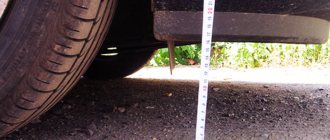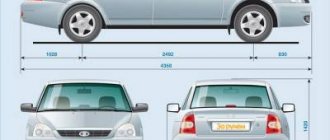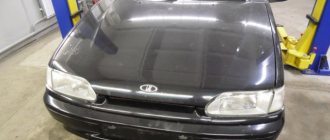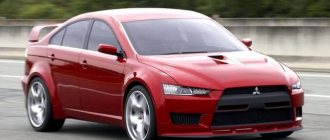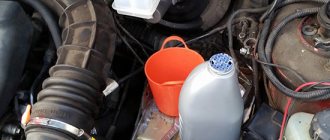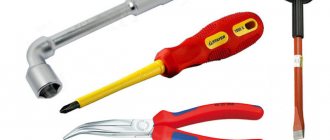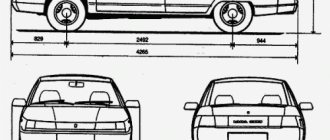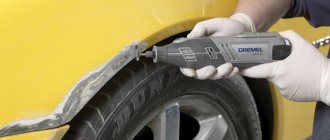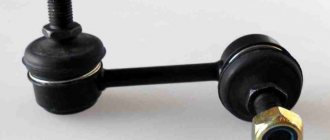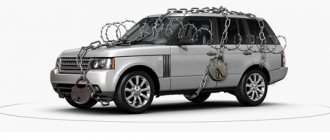Roads in Russia and the CIS countries are rarely pleased with their quality, so when choosing a car, people are forced to focus on the amount of ground clearance (car clearance).
It is believed that the higher this indicator, the better. But this rule does not work for everyone. There are extreme sports enthusiasts who set themselves the opposite goal - to lower the suspension.
But why? What methods are there? What are their features? Let's discuss these issues in more detail.
What is it for
It may seem to you that there is no logic in such a change. In fact, a number of problems are being solved here.
Firstly, lowering the ground clearance gives the car a sportier look (even domestic VAZ products look different).
Secondly, the car shows better stability when cornering (especially when driving at high speed). By the way, this is explained by a decrease in the level of the center of gravity.
Thirdly, less air resistance allows you to reach higher speeds and save a little on fuel.
Reviews from car enthusiasts about lowering the Priora suspension
Suspension 2110, supports VAZ 2110, front shock absorbers Plaza Sport shortened -50 gas oil, rear Bilstein b8 gazmas, springs all around Eibach -45 pro kit. To be honest, Eibachs lower the front well, but the rear is almost like stock. I put standard and Eibach springs next to each other, the difference is a centimeter and a half. I didn’t like the fact that the rear didn’t sit down at all and I put the phobos back: they really lowered them - 50, although they were on the 12 and sagged a little. Therefore, I would like the front to be a little lower.
hATE
https://www.lada-priora.ru/forum/showthread.php?p=226489
Understated. The racks around the SAAZ are ten-size, with shortened rods. In front there are TechnoRessor -90 springs, SS20 queen support springs (with a lowering of 1 cm), at the rear I cut off the original springs by 3 turns. The struts were pumped up for stiffness, because... the rod stroke is short. Bottom line, the car is a bouncer, it’s very rough, I feel every bump, a small wave - me and the sub in the trunk are bouncing.
byxoiLeXX
https://www.lada-priora.ru/forum/showthread.php?p=226489
On the original struts, put -30 in the rear, -70 in the front, it will lie flat. At first I set everything to -30, the rear was as it should be, the front was generally as it was, then I changed the front ones to -50 and still 2 cm higher than the rear.
Kova1enko
https://www.car72.ru/forum/viewtopic.php?t=73965&start=30
The Demfi struts themselves are a bit harsh. I have a KX -90, the springs are TechnoRessor -90 and two more coils have been sawn off at the back. I drive and rejoice, low and soft.
kos-jz
https://www.drive2.ru/communities/4035225266123971064/forum/288230376153233401
Lowering a car suspension is not an amateur activity. However, if you decide to carry out this procedure with your Priora, you need to familiarize yourself with the possible options, choosing the most suitable one. It is advisable to entrust changes to the suspension to an experienced mechanic or use special kits for lowering the landing, which you can easily install yourself.
What is the danger
As practice shows, reducing the lumen brings more problems than benefits:
- any hole or other unevenness in the road can lead to damage to an important element of the car (engine, exhaust or chassis system). After such tuning, the car becomes a frequent visitor to service stations;
- after the modification, the stiffness of the suspension increases, which is unlikely to please the passengers of the car;
- unskilled work can lead to rapid failure of many elements of the chassis system (primarily shock absorbers).
Precautions when tuning the “fourteenth”
When increasing the ground clearance of the VAZ 2114, moderation should be observed. It is still possible to increase the clearance by 5 centimeters, but by 10 it is no longer worth it. The fact is that by carrying out such tuning, you make noticeable changes to the design of the car. This is due to the raising of the vehicle's center of gravity (CG).
The standard height of the CG of a car without tuning above the road surface is 56 cm. The weight of the car is about 50 kg. Calculations show that raising the car by 5 cm is similar to placing a load of approximately 40 kilograms on the roof of your “fourteenth”. So imagine that you are entering a turn at a speed of 90 km/h with a couple of heavy bags of potatoes on the roof rack. You will closely simulate the behavior of a car with increased ground clearance in a high-speed turn.
Before you start tuning, evaluate again how often you have to climb curbs exactly 19 centimeters high and drive through cutting areas between stumps exactly 18 to 22 centimeters high. Maybe you shouldn’t fence your garden... Be careful, take care of yourself.
There is less danger in lowering the car due to the use of shorter shock-absorbing elements, but even in this case it is necessary to take care of the compatibility of the tuning elements with the basic design. Low springs can be dangerous when hitting an obstacle.
Shortening springs
Shortening springs. This method is in demand for one simple reason - it is the most budget-friendly.
You can do this work yourself or safely entrust it to a novice car mechanic.
There is nothing complicated here. All you need is a jack, pry bars and a metal file (preferably a grinder).
You can reduce the size of the spring with or without installing the spring (here everyone chooses for themselves).
In this case, the front and rear springs are shortened by a different number of upper turns (by two and three, respectively).
This trick is due to the need to balance the car, because the front one (which is quite logical) has much more weight. After shortening the springs, wheel alignment is required.
The advantage of the spring shortening method is minimal costs.
Disadvantages - increased suspension rigidity and a high risk of breaking the shortened spring and shock absorber.
How to lower a VAZ 2114 correctly
Post by tazmen72 » 07 Jul 2012, 14:33
I've been reading the forum for a long time, but I decided to register and ask for advice on undervaluation.
what we have: 2114 with standard suspension, r13 wheels, 175/75 tires
in the future I plan to change the wheels to white forged r15 with tires something like 195/50
you need to lower it without sawing the arches or shuffling your wheels against them.
Which struts with springs are best to buy? Or maybe it’s better to cut the drain, because I don’t need rigidity, but I need a beautiful fit? And is it really possible to do it yourself, is there a lot of hassle in replacing the struts, or should I go to a hundred?
Now I’ll try to find pictures of chepyreks on the Internet with a lowering that I like
Lowering a car (for example, lowering a VAZ ) is one of the most common areas of tuning a VAZ.
The most common solution for novice tuners is to take and cut off several coils of suspension springs. Some manage to do this without even removing the shock absorbers from the car. This approach to undervaluing a car is fundamentally wrong.
Installation of lower springs
Installation of lower springs. If you do not want to cut existing springs, you can buy new products that have a lower height (such springs are often called sports springs).
Their main difference is the height, which is four centimeters less than in standard models.
If you want to save money, then you can lower the suspension this way without outside help. If in doubt, it is better to contact specialists in this matter. Moreover, the alignment will still have to be done.
The advantage of this method is its comparative simplicity and the ability to quickly return everything to its place (install old springs). Another advantage of sports springs is that they have greater rigidity and do not sag as much as standard (hand-shortened) products.
The disadvantage is the cost of purchasing new springs, as well as increasing the overall rigidity of the car. But with this type of tuning this is a common occurrence.
Lowering springs SS20 Racing for VAZ
The SS20 Racing lowering springs are a new addition to the SS20 SPORT series of products for drivers who prefer a fast, active driving style. These are springs for those who care not only about the appearance of the car, but also about the correct operation of the suspension and steering when the ground clearance is lowered, confidence and safety on sharp turns.
SS20 Racing lowering springs have the following features
- made of high-quality Japanese steel using the cold-winding , which significantly increases the service life;
- have progressive characteristics: optimal suspension stiffness at low loads and a proportional increase in stiffness as the vehicle load increases, during roll when cornering or extreme braking;
- matched in pairs with identical characteristics, which ensures even lowering without body distortion;
- work without shrinkage 2 times longer than hot-rolled springs;
- the weight of the springs is reduced to 25% compared to the standard ones (depending on the car model);
- have a durable and resistant powder coating that protects against corrosion;
- have a polyurethane protective braid that protects the coils from damage when closed;
- When installed with SS20 Racing Series shocks, these springs provide your choice of -30, -50, -70 or -90mm drop.
Lowering a car or reducing ground clearance is one of the most modern areas of tuning today. To give their car confidence in driving, stability when maneuvering at a decent speed, and simply make it more stylish and sporty, car owners use different methods.
Some people simply cut through the springs due to lack of information or finances. You can’t expect a super effect from such economical tuning. But it’s cheap, and the car looks sporty and stylish in appearance. But you have to pay for this with convenience - you ride “like on a stool”, strong vibration shakes up the interior and everything starts to rattle. But this is not even the main thing: when cutting standard springs, it is impossible to achieve their identical characteristics, and this method leads to deformation and weakening of the body, gradual destruction of the front suspension cups, hard metal impacts on the body, and the appearance of cracks. And these are irrevocable serious losses that significantly reduce the performance and cost of the car.
Another option is that if you have the financial means, you can buy expensive suspension parts from the best manufacturers and assemble everything together. But it is not a fact that after this you will get what you dreamed of. Because to lower a car you need not only good expensive hardware, but also their coordinated work and the correct calculation of each suspension element. Moreover, it is necessary to take into account the changes made to the suspension geometry, and try to maintain the controllability and comfort of the car, and not disrupt the operation of the braking system.
We hope that the previous arguments were convincing. All this led us to the creation of KITs for lowering (“kits” - translation from English), in which springs play one of the main roles in lowering. Springs - it seems, what could be simpler - a piece of wire twisted into a spiral, that's all. But for some reason, not every manufacturer can produce high-quality, reliable and durable springs that will work stably, will not sag over time and, most importantly, will be manufactured exactly according to the design parameters.
Good springs are technologically sophisticated products made from high-quality metal. The working load of a lowering spring is much higher than that of a regular spring. Lowering springs (sport springs) absorb the same shock from the road as regular springs, but they are short and must absorb bumps with less compression travel of the suspension.
This feature was taken into account when designing and testing the SS20 Racing lowering springs. As a result, due to special Japanese steel, the use of the **cold coiling** method in production, a durable protective coating and a special protective braiding that protects the coils from damage when closing, SS20 Racing lowering springs work without shrinkage twice as long as hot coil springs, currently widely available on the market.
sports springs have progressive characteristics, that is, they provide lowering of the car without loss of comfort: optimal suspension stiffness at low loads and a proportional increase in stiffness as the vehicle load increases, during roll in a corner or sudden braking.
Depending on the vehicle model and the amount of lowering, the weight of SS20 Racing springs is reduced by up to 25% compared to standard springs (except for springs SS30136 and SS30137). Reducing the weight of springs, together with reducing the weight of shock absorbers, reduces unsprung masses in the car’s suspension, which has a positive effect on driving performance, reduces dynamic loads in the suspension, improves acceleration and braking dynamics and contributes to improved handling.
The energy intensity of the suspension with lowered springs is calculated and maintained due to increased spring stiffness. Thanks to this, the lowered car remains comfortable, and shocks to the body when overcoming bumps are reduced.
All SS20 Racing springs are tested on a control stand and are selected in pairs with the same characteristics, so they provide uniform lowering without body distortion, stability and driving safety.
Marking
In addition to lowering springs, the SS20 company produces classic hot-coiled springs and Gold springs with variable coil pitch.
Coilovers
Another method to reduce ride height is to install coilovers (adjustable sports springs). This is very convenient, because you can adjust the vehicle’s ground clearance at any time.
Advantages of installing coilovers:
- versatility. They can be adapted to any shock absorbers - both regular and sports;
- possibility of adjustment. Just a few minutes and the necessary changes to the ground clearance are made;
- ease of installation. If you wish, you can do all the work yourself.
There is only one drawback - the need to spend money on purchasing these devices.
What is car clearance
GOST interprets ground clearance, or ground clearance, as the distance from the road surface to the lowest point of the car. At first glance, everything is clear. But only for the first one. The lowest point may be a point on the bottom of the engine crankcase. Or crankcase protection, if there is one. Or the clutch housing. Or the exhaust system. Or the lower shock absorber strut brackets. How many cars there are, so many lower points and, accordingly, distances to the roadway.
You also need to take into account the load on the car when measuring ground clearance. The Russian standard requires measurements to be taken at full load, that is, with the maximum number of passengers, the trunk loaded and the fuel tank filled. In the documentation of many foreign cars, technical characteristics are indicated with only one driver in the cabin and without luggage.
And the manufacturer’s documentation often provides for the use of several tire options, the sizes of which differ from each other. At the same time, ground clearances are also different. For these reasons, the VAZ 2114 manufacturer’s documentation contains two ground clearance values:
- at the bottom point of the engine sump - 170 mm;
- at the lower point of the clutch housing - 160 mm.
The VAZ 2114, like most domestic models, has quite sufficient ground clearance by the standards of its class.
Air suspension installation
Installing an air suspension is an option for real tuning fans. Why? – Yes, because the cost of such an alteration amounts to several thousand, or even tens of thousands of rubles.
To organize the process, you need to spend money on the purchase of air bags (for the front and rear), pressure sensors (they monitor pressure indicators in the above-mentioned bags), a receiver, a compressor (for inflation) and a control panel.
But the high cost of all the components listed above is still half the problem. You must be prepared for the costly installation of all equipment. This kind of work cannot be entrusted to some “Vasya from the garage.”
Installation of air springs should only be carried out by qualified specialists and only at specialized service stations.
This is a whole range of work, which includes the removal of existing struts, springs, as well as the proper installation of air bags, sensors, a compressor and other equipment that we have already mentioned.
If the system is configured correctly, it is possible to lower the suspension to the required level at any time or return it all back. You can focus on many factors - terrain, road quality, driving mode, and so on.
The advantage of this method is the ability to adjust the ground clearance over a wide range (ground clearance can be changed from one to five centimeters).
In addition, installing such a suspension improves the characteristics of the car (primarily its handling at high speeds).
There is another undeniable plus - air springs hold weight well, so they do not sag even when the vehicle is maximally loaded.
But there are also disadvantages.
- Firstly, the high cost of modifications, which not all tuning lovers can afford.
- Secondly, the short “life” of pillows, which do not withstand domestic roads for a long time. In addition, due to constant shaking, the pressure control sensors also “give up.”
Disadvantages of understatement
If you decide to perform this procedure using a technical means, it is worth remembering that there are advantages and disadvantages. Among the negative characteristics of lowering a car, the following main ones can be identified:
- Once the car gets much lower, it becomes very difficult to tow it. It is also completely impossible to pull other cars, because if you attach a tow rope to the bumper, then it simply cannot withstand a certain load and breaks.
- Some elements of the road can become quite a strong obstacle. So, speed bumps can cause a lowered car to hang a little on them.
- This procedure is ideal only for smooth roads. After lowering it will be completely impossible to go out into nature: into the forest, to a pond, to a river. Even the smallest stones will become a huge obstacle to your technical equipment.
- Very often you will hear the sound of a muffler catching on a less than perfectly level road.
Understatement is done to obtain maximum contact between the car engine and the wheels of the car. It helps the vehicle stay on the road better, especially on slippery asphalt. Appearance - very overloaded. The inclination of the wheel changes. Vehicle controllability may deteriorate. Due to lowering, tires wear out quickly. To avoid these consequences, after the procedure you need a camber set. It helps to set the correct wheel angle. You can also purchase other levers.
If you have finally decided to lower your car, then it is worth remembering that before starting work you will need to decide on the method of this procedure and only then can you proceed to work. It is also worth carefully weighing both the advantages and disadvantages of this process.
Reducing the clearance on a VAZ
In the case of lowering the suspension of a VAZ “classic”, a special approach to work is required. Simply cutting off the springs is not the best option, because after just a few tens of kilometers the car can become severely distorted. And it’s not far from breaking the shock absorber and the spring itself.
The best option is to install low springs. But at the same time, it is advisable to select suitable shock absorbers.
For example, if you plan to reduce the ground clearance by 40-50 mm, then it is worth buying shock absorbers that can work in such conditions. It is strictly forbidden to lose sight of this moment.
On VAZ cars, the ride height can be adjusted in the range from 20 to 90 mm. Anything more than nine centimeters is already dangerous. And it is almost impossible to implement this in practice.
To make the suspension durable, it is necessary to install new boots and rebound buffers during installation. But that's not all.
It would be a good idea to replace the support bearings on the front struts (this will significantly reduce the force on the steering wheel).
The biggest disadvantage that needs to be eliminated
Now I want to talk about one significant disadvantage that you will have to face when installing original springs paired with SS20 struts and supports from the same company. As mentioned above, the rod is slightly longer than on the factory SAAZ. It turns out that when the car wheel is fully suspended and the steering wheel is turned all the way, the tie rod tightening bolts will cling to the end of the hole in the body. This is what it looks like in practice:
You can take my word for it that one such time, when the steering wheel is fully turned in one direction or the other, the metal at the point of contact is crushed and the following damage occurs:
In fact, I don’t see anything critical in this, since when turning again everything goes almost smoothly. If you want to get rid of constant clinging, you can use pliers to bend the required section of metal in the hole from below (at the point of contact). Of course, I’m not sure that I’m strong enough to do this with pliers, but I can try. Or use a round file to do it more civilly. But after that you will definitely need to carefully treat this place with an anticorrosive agent, and the more, the better. I haven’t done this yet, but on my first trip to the village I’ll do it, since the bottle of mastic was left there.
Another point that may arise, but I personally have not noticed this. Since the rack has become longer when fully suspended, the brake hose is tightened more, but not critically. In my case, the tension is quite acceptable, which is unlikely to lead to a break.
In general, of course, that moment with metal damage is not very pleasant, but I don’t really bother about it, I’ll do everything in the near future, file a couple of millimeters or bend it even further so that nothing sticks anymore, and then thoroughly fill this place with anti-corrosion treatment . I wanted to describe my new spring ties in this article, but I’m already thinking that it’s better to make a separate post about this.
Spring sizes — Lada 2104, 1.4 l., 1997 on DRIVE2
Perhaps this article will be to the taste of some car enthusiasts!
Brief technical characteristics of springs
Front suspension springs
Spring model: 2101 Rod diameter, mm: 13.1 Outer diameter, mm: 116.3 Number of turns: 8.75 Length mm: 360
Spring coating: epoxy, black enamel
Spring model: 21012 Rod diameter, mm: 13.5 Outer diameter, mm: 117 Number of turns: 8.75 Length mm: 360
Spring coating: epoxy, black enamel
Spring model: 2121 Rod diameter, mm: 15.2 Outer diameter, mm: 120.4 Number of turns: 7.3 Length mm: 278
Spring coating: epoxy
Spring model: 2108 Rod diameter, mm: 12.9 Outer diameter, mm: 149.6–151.6 Number of turns: 7 Length mm: 383.5
Spring coating: epoxy, black enamel
Spring model: 2108 European Rod diameter, mm: 12.9 Outer diameter, mm: 149.6–151.6 Number of turns: 7 Length mm: 364.5
Spring coating: epoxy, black enamel
Spring model: 2112 Rod diameter, mm: 13.2 Outer diameter, mm: 151.2 Number of turns: 7 Length mm: 383.5
Spring coating: epoxy, black enamel
Spring model: 1111 Rod diameter, mm: 10 Outer diameter, mm: 94–95 Number of turns: 9.3 Length mm: 316.8
Spring coating: epoxy, black enamel
Rear suspension springs
Spring model: 2101 Rod diameter, mm: 12.4 Outer diameter, mm: 127.5 Number of turns: 9.3 Length mm: 434
Spring coating: epoxy
Spring model: 2102 Rod diameter, mm: 12.4 Outer diameter, mm: 127.5 Number of turns: 9.3 Length mm: 455
Spring coating: epoxy
Spring model: 2121 Rod diameter, mm: 12.7 Outer diameter, mm: 127–129 Number of turns: 9.3 Length mm: 434
Spring coating: epoxy
Spring model: 2108 Rod diameter, mm: 11.2 Outer diameter, mm: 107.2 Number of turns: 11.5 Length mm: 418
Spring coating: epoxy
Spring model: 2108 European Rod diameter, mm: 11.2 Outer diameter, mm: 107.2 Number of turns: 10.5 Length mm: 381
Spring coating: epoxy
Spring model: 2110 Rod diameter, mm: 11.6 Outer diameter, mm: 108 Number of turns: 10.5 Length mm: 381
Spring coating: epoxy
Spring model: 2110 European Rod diameter, mm: 11.6 Outer diameter, mm: 108 Number of turns: 11.5 Length mm: 403
Spring coating: epoxy
Spring model: 1111 Rod diameter, mm: 9.7 Outer diameter, mm: 99.7 Number of turns: 9.5 Length mm: 353
Spring coating: epoxy, black enamel
Spring sizes of domestic cars
The article indicates the sizes of springs used in domestic cars
The actual data in the table
Rod diameter, mm, tolerance 0.05
Outer diameter, mm / Tolerance
Spring height, mm
The color of the spring is not a constant value. Different manufacturers may change this color. The thickness of the rod is also a question; for example, Phobos makes springs even with variable rod thickness. He (Phobos) makes springs with variable pitch, therefore, cannot withstand the specified number of turns. The height can also vary, because... Some manufacturers, to simplify the technology, make the rear springs 2101 and 2102/04 the same height, but of different stiffness. Other manufacturers reduce the height to increase the stability of the car in corners. Therefore, to identify springs, it is most appropriate to use the outer diameter of the spring, because this size is attached to the car, and spring manufacturers cannot change it arbitrarily. Springs of the same diameter can be distinguished by the color of the marking, because... this is also an established standard with some tolerance for color perception (for example, red = brown).
The article is based on data from the site https://abvgd-auto.narod.ru
